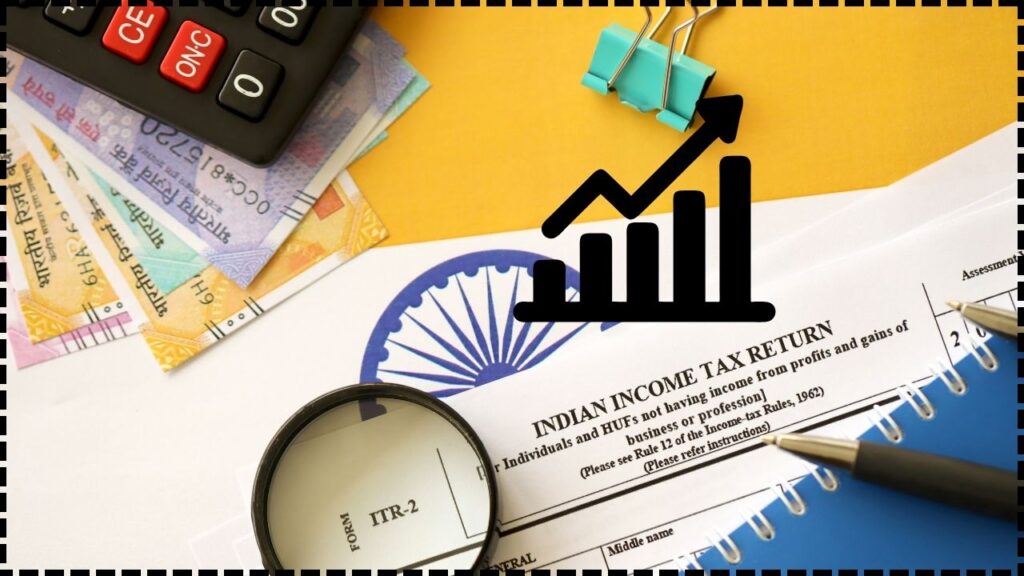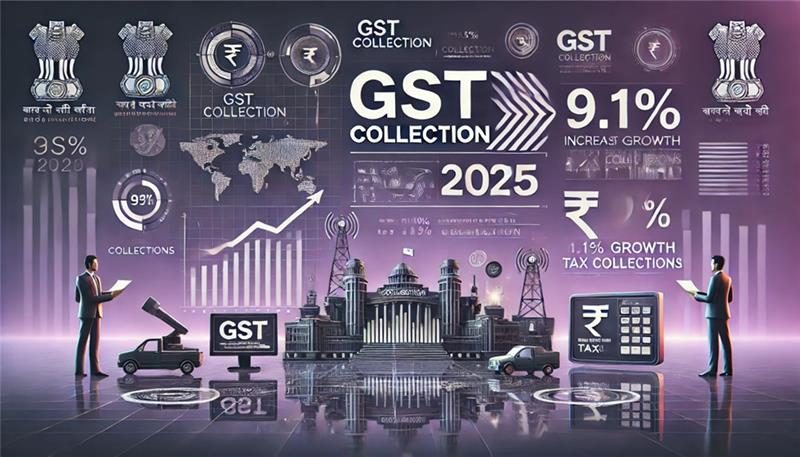GST Collection Breaks ₹1.96 Lakh Crore Mark: India’s tax revenue story in July 2025 made headlines: the Goods and Services Tax (GST) collection touched ₹1.96 lakh crore, one of the highest since the tax’s inception in 2017. That’s a big deal. But dig a little deeper, and there’s a surprising twist — net GST revenue, the amount the government actually keeps, rose just 1.7% year-over-year (YoY). Now, if you’re wondering why that is, you’re not alone. Businesses, economists, policymakers, and everyday taxpayers are all asking the same thing: “If we’re collecting more, why aren’t we earning more?” In this article, we’ll unpack this paradox — and explain it in a way that even a middle-schooler can grasp. Let’s start with the big picture, then we’ll zoom in on the numbers and insights that matter.
GST Collection Breaks ₹1.96 Lakh Crore Mark
India’s GST system is evolving. July 2025’s gross collection of ₹1.96 lakh crore is a headline win, but the 1.7% net growth shows the road ahead isn’t without bumps. With refunds rising, domestic demand cooling, and structural issues like inverted duties continuing, businesses and policymakers alike have a challenge on their hands. For professionals, it’s a time to stay vigilant, stay compliant, and plan financially for a fluid tax regime. The data may look mixed now — but with the right reforms and economic revival, both gross and net GST numbers can align for stronger, sustained growth.

| Metric | Value | YoY Change |
|---|---|---|
| Gross GST Revenue | ₹1.96 lakh crore | +7.5% |
| Net GST Revenue | ₹1.69 lakh crore | +1.7% |
| GST Refunds Issued | ₹27,150 crore | +66.8% |
| Domestic Supply Net GST | ₹1.26 lakh crore | −0.2% |
| Import-Related GST | ₹43,000+ crore (est.) | +7–9% |
| Refunds on Domestic Transactions | ₹15,000+ crore | +117% |
| Official Source | gst.gov.in |
What Is GST, and Why Should You Care?
Let’s strip it down. GST is a single indirect tax that replaced multiple taxes like VAT, excise, and service tax. It’s levied on the sale of goods and services and collected by businesses — who then deposit it with the government.
But here’s the kicker: not all GST collected stays with the government. Due to input tax credit (ITC) and refunds, businesses often get a chunk of that tax money back. That means gross collections may look high, but net revenue (actual money retained by the government) could be much lower.
Think of it like this: You earn $5,000 a month, but after paying loans, taxes, and bills, you only get to keep $2,000. Same concept.

Why Is Net GST Growth Slowing Despite GST Collection Breaks ₹1.96 Lakh Crore Mark?
Here’s a breakdown of the top reasons:
1. Massive Spike in Refunds
The most obvious reason is the 66.8% increase in refunds, totaling ₹27,150 crore in July 2025. Refunds from domestic supplies alone more than doubled compared to last year. That’s a lot of money going back into business bank accounts instead of government coffers.
Refunds are triggered by:
- Exporters, who aren’t taxed domestically
- Inverted duty structures (where tax on inputs is higher than on outputs)
- Large ITC balances due to slow B2C sales
While it’s great for business liquidity, it’s tough on government cash flow.
2. Flat or Declining Domestic Demand
GST revenue from domestic trade actually dropped 0.2% in July. That means while imports are growing, consumption within India might be tapering. A few reasons why:
- Middle-class and rural demand is under pressure
- Inflation and high interest rates are curbing discretionary spending
- Some sectors, like real estate and FMCG, are seeing stagnation
Sluggish internal trade means less GST collected on goods and services sold within the country.
3. The Curse of Inverted Duty Structures
This one’s a technical but important factor. In some sectors — like textiles, electronics, fertilizers — the inputs are taxed higher than the outputs. So when a business sells a final product, it ends up paying less GST than what it paid on raw materials.
That imbalance results in:
- Excess ITC
- Higher refund claims
- Distorted tax incentives
For example, if a mobile phone company buys components taxed at 18% but sells the finished phone taxed at 12%, it will always be in refund mode.
4. Slower Growth in Core Tax Components
Two major contributors to net revenue — CGST (central tax) and SGST (state tax) — grew only about 4–8% in July. Meanwhile, compensation cess, which is levied on luxury and sin goods like SUVs and tobacco, contracted by 2% YoY.
That’s significant because:
- States rely on cess to compensate for GST revenue shortfall
- A drop here suggests weakening demand in high-ticket discretionary items
5. Faster Refund Processing = Lower Retention
Ironically, the government’s move to speed up refund processing is a double-edged sword. Businesses are getting their dues faster — but it also means less money stays with the government each month.
Earlier, refunds might lag by a quarter or more. Now, they’re being issued within the same month, which compresses net growth data.

Understanding How GST Collections Work: A Quick Guide
Step 1: Tax is Collected
When you buy a service or product, GST is added to the price — usually between 5% to 28%. Businesses collect this on behalf of the government.
Step 2: Input Tax Credit Is Claimed
Companies subtract the tax they already paid on inputs from what they collected. This prevents double taxation.
Example:
- GST paid on raw materials: ₹1,000
- GST collected on finished goods: ₹1,500
- Net tax payable: ₹500
Step 3: Monthly Returns Are Filed
Every month, businesses file GSTR-3B and GSTR-1 returns, showing their GST liabilities and ITC claims.
Step 4: Refunds Are Claimed and Issued
If a company has excess ITC or is eligible for refunds (like exporters), they file for it. Once approved, the government issues the refund, reducing net collections.
What This Means for Businesses and Professionals?
If you’re running a business or advising one, these trends aren’t just academic — they directly affect:
1. Cash Flow Planning
If you’re refund-dependent, faster disbursals are a plus. But ensure your filings are error-free and well-documented. Incorrect returns could delay payments or attract scrutiny.
2. Working Capital Management
Inverted duty sectors may experience regular cash crunches. Plan purchases and production cycles to manage ITC wisely.
3. Compliance Pressure
With refunds growing, expect more audits. The government will likely ramp up assessments to curb fraud and wrongful claims.
4. Pricing Strategy
GST slab changes and rate rationalizations are likely on the horizon. If your industry is prone to slab shifts (like food, pharma, or electronics), you’ll want to stay agile.
Real-World Impact: State-Level Variations
Interestingly, the impact of GST revenue growth varies by state. For example:
- Punjab saw over 44% growth in GST collections in June 2025.
- Haryana reported 12% growth.
- Gujarat, Tamil Nadu, and Maharashtra reported flat or single-digit growth.
This implies:
- Some regions are experiencing robust industrial activity
- Others are dealing with consumption fatigue or compliance slippages
State-level trends will play a bigger role in GST Council decision-making going forward.
What’s Next? A Look at the Road Ahead
1. Rate Rationalization Is on the Table
The GST Council is reviewing inverted duty structures to reduce refund dependency. Expect tweaks in tax slabs, especially in electronics, textiles, and chemicals.
2. Compliance & Audit Push
With net revenue slowing and refunds ballooning, authorities will focus more on:
- AI-based return scrutiny
- Randomized audits
- Blocking fake ITC networks
3. Simplified Returns for Small Businesses
A revised return filing system could ease compliance for MSMEs while tightening controls on larger refund-heavy businesses.
Telangana High Court Delivers Major Relief for NRSC in GST Dispute
GST Portal to Be Down August 2–3 — Check Exact Hours Before Filing
Cabinet Greenlights Major GST Act Amendments—What These Changes Mean for Businesses and Consumers










